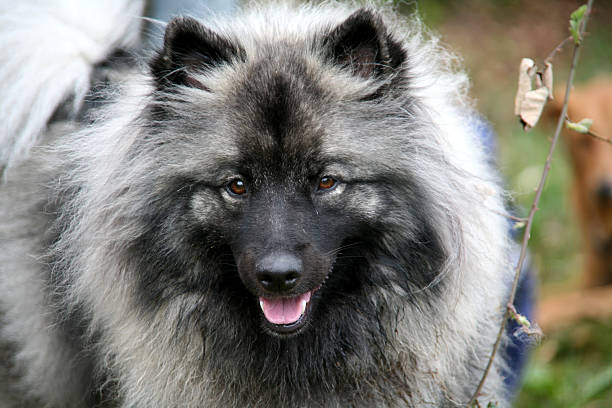The Wolfsspitz is a typical German farm dog that was one of the most popular breeds on German farms from the Middle Ages to the 19th century. The frugal guard dog is said to get by with potatoes – we don’t let it matter and explain what the species-appropriate husbandry of the Wolfsspitz looks like.
The Modern Form of the Stone Age Torfspitze
The Wolfspitz shares a breed standard with its close relatives, the Large, Medium, Small, and Pomeranian Spitz (Pomeranians). With a permissible height at the withers of between 43 and 55 cm (ideally 49 cm), it is the largest German Spitz and weighs only around 15 to 20 kg. It can be easily distinguished from other types by its gray, clouded coat color.
Easily seen under the spikes

- The Finnish Spitz (Suomenpystykorva) has shorter, fox red fur compared to the fluffy fur of the Wolf Spitz.
- Volpino Italiano, American Eskimo Dog, and Japanese Spitz are bred in pure white only, as is the Samoyed Dog.
- Eurasiers are taller and have smoother, shorter fur than Wolfsspitz. They come in all colors.
- The smooth-haired Elo (large Elo) descends from the Eurasier and secondarily from the Wolfsspitz. He is built much stockier and has a broader head than the tip.
From the pointed nose to the curling tail: the breed standard at a glance
- The face of the Wolfspitz has very short hair. The plush fur starts behind the ears and reaches almost to the cheeks on the neck and a dark mask is visible on the face. The head is wedge-shaped, the muzzle should not be too long and neither blunt nor exaggeratedly pointed.
- The nose is very small, round, and always black. The strong, perfectly meshing fangs are particularly emphasized. Gently rounded cheeks clearly differentiate the head shape from German shepherds and greyhounds.
- The lids around the almond-shaped eyes, which are not too large and are slightly slanted, are colored black. The iris should also be colored as dark as possible. The friendly expression is more like that of the Samoyed than that of the Siberian Husky or Malamute.
- The triangular prick ears are quite small and stand close together. They taper to a point and are covered with dense, short hair, which is usually dark against the silvery-grey head.
- The medium-length and strong neck is slightly arched in the neck. Due to the rich mane around the neck and neck, the front part of the body is hardly visible. The back is short, straight, and strong, as are the broad and strong loins. The chest and forecast are well developed, the underline is barely tucked up on the belly. Overall, the body should appear square (long as high).
- The fore and hind legs are supported by strong bones and are almost vertical. The knee is hardly bent and the pasterns are very strong and straight. The cat’s paws should be small and rounded, with well-developed pads and claws that are as dark as possible.
- A particularly characteristic feature is the bushy curled tail, which is worn lying on the back and rounds off the silhouette.
The gray clouded Spitz: coat and colors
Wolfsspitz only comes in one color variant, the shades of which can sometimes be darker and sometimes lighter. The firm top coat sticks out straight and long in all directions, underneath is a thick, fluffy undercoat. The bushy mane around the neck, the tail, and the back of the legs are particularly richly feathered. The front of the legs, like the ears and face, have very dense and short hair. Curls, parting, or waves never occur in purebred wolf spitz.
What does cloudy mean?
This coloring, which is rather rare in the dog world, distinguishes the Keeshond. The coat consists of two-tone hairs that appear darker at the tips and silvery gray at the base. This creates dark clouds like the Zobel dye (but without the brown tinge).
- A black line runs from the outer corner of the eye to the base of the ear.
- The ears and muzzle are always dark in color.
- The eyebrows stand out darkly.
- The neck and shoulders appear silvery-gray (never pure white), and the fur on the underside of the tail and on the legs is lightest.
- The tip of the tail should be black.
The Tale of the Wolfspitz: Peat Dog or No Peat Dog?
It has long been assumed that the Wolfsspitz is a direct descendant of the Stone Age peat dog, which was kept in the Neolithic period. So far, however, this suspicion has not been confirmed by genetic analysis. The Wolfsspitz is undoubtedly the oldest Spitz breed and also one of the oldest domestic dog breeds in Germany. Throughout the Middle Ages, Wolfsspitz were the most widespread dog breed, from which other types only gradually formed. In the early days of modern dog breeding, the first breed standard for the Wolfsspitz was set in Berlin (1880).
Useful patron saint of house and yard
- Lace has traditionally been kept free-roaming on farms for centuries.
- They reliably indicate intruders and bark at foxes and other predators.
- It is said that the frugal animals can also be fed with potatoes in times of need. In times of war, therefore, its popularity increased.
The Keeshond Abroad

The breed spread among European nobility early on. Abroad, the Spitz, known from 1780 as the Keeshond, was bred to be smaller and sleeker than in Germany. Only in 1933 was the smaller, Dutch type included in the breed standard. Famous representatives of the Wolfspitz were the court dogs of King George III. and George IV and the prominent four-legged hand of a prominent Dutch politician named Kees.